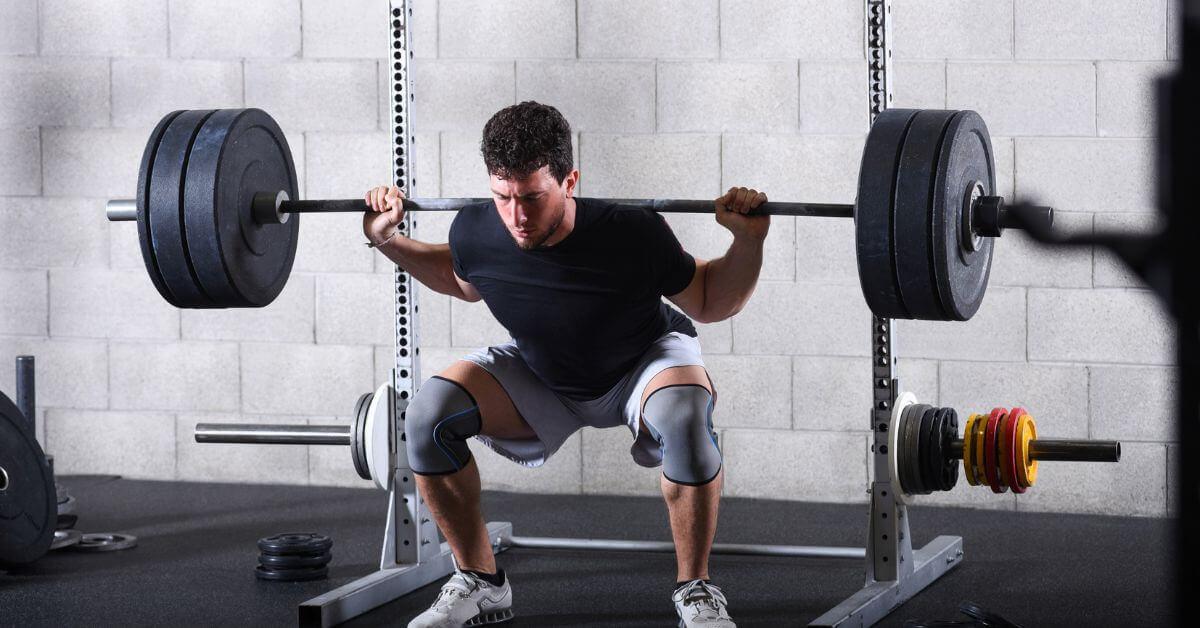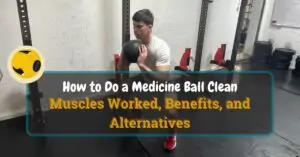If you have been looking to train more functionally and stop basing your training programs solely on isolation exercises, you must have come across compound exercises.
Table of Contents
ToggleCompound exercises, or in another word, compound movements, are one of the pillars of today’s athletic performance. Understanding what is a compound exercise is crucial for anyone looking to enhance their overall fitness and strength.
They are heavily used in sport-specific scenarios since they transition far better than isolation exercises, making the athlete faster, stronger, more explosive, and so on.
There is nothing wrong with incorporating isolation exercises into your training schedule.
Still, in my opinion, compound exercises are far more important because they will yield more benefits in all realms of human locomotion. Compound workouts effectively enhance muscle coordination and strength by engaging multiple muscle groups simultaneously.
In this article, I will cover everything you need to know about compound exercises, their benefits, actual exercises, how to incorporate them into your workouts, and more. Whether you’re looking for compound exercises at home or in the gym, this guide has you covered.
Start Building Your Dream Body Today
Ready to elevate your fitness game without falling into the trap of dull, repetitive routines that just don’t deliver? Imagine sculpting your ideal physique and boosting your health, all while still enjoying life’s pleasures, like those irresistible weekend getaways and your aunt’s legendary cheesecake. With our online fitness and nutrition coaching service, you don’t have to compromise. Dive into a personalized fitness journey that blends perfectly with your lifestyle, not against it. Book your completely free discovery consultation today, and take the first step towards a transformation that doesn’t require giving up the joys of life.

“I was skeptical about online fitness coaching, but Functional Body Savage completely changed my perspective. Vanja and Radomir’s personalized approach and attention to detail have helped me achieve goals I never thought possible. I’m stronger, more confident, and grateful for their guidance.”
Emily Thompson, San Francisco, CA
Learn More About Our Online Coaching ServiceQuick Summary
- Compound exercises use multiple muscles, muscle groups, and joints to complete the movement.
- These multi muscle exercises are integral to developing comprehensive strength and functionality.
- Compound exercises are the pillars of building a well-balanced and strong body.
- Compound exercises for building a strong, resilient, and well-balanced body include squats, lunges, deadlifts, bench presses, rowing, overhead press, and pull-ups.
- Compound exercises improve your intermuscular coordination, build lean muscle, and significantly affect your daily movements.
- Compound exercises have the biggest carryover to daily activities and athletic performance.
What Are Compound Exercises?
Compound exercises are all exercises that use multiple muscles or muscle groups to initiate a movement. In addition, compound exercises predominantly use multiple joints, making them more functional in the sense of imitating human movement patterns.
This is why they are often included in compound gym exercises to enhance overall athletic performance. Compound exercises or compound movements, as I like to call them, are the pillars of a highly-effective functional training program.
Examples of compound exercises include push-ups, pull-ups, deadlifts, squats, and more. These exercises are staples in any compound exercises list, ensuring you cover all essential movements.
As you can see, all these functional exercises use large muscle groups together to complete the movement.
For example, while performing squats, you will activate muscles such as the quadriceps, consisting of four muscles, including rectus femoris, vastus medialis, vastus lateralis, and vastus intermedius.
However, squats will also activate posterior chain muscles, such as hamstrings consisting of semitendinosus, semimembranosus, biceps femoris, and glute complex consisting of gluteus maximus, gluteus medium, and gluteus minimus.
In the Olympic lifting and powerlifting world, people refer to compound exercises as three big lifts, including bench press, deadlift, and squat.
What Are the Benefits of Compound Exercises?
The benefits of compound exercises are improved intermuscular coordination, cardiovascular health, mobility, movement efficiency, lean muscle tissue, strength, and increased testosterone and growth hormone levels. Incorporating between 3 and 6 compound exercises into your routine can maximize these benefits.
Here is a brief overview of each of these benefits.
1. Compound Exercises Burn More Calories
Compound exercises burn more calories because they involve more muscles to complete the movement. Muscles burn calories to keep the body’s temperature stable(temperature homeostasis) [1]. By integrating compound exercises into your routine, you can efficiently boost your metabolism and overall calorie expenditure.
When we initiate the movement, our muscle burns significantly more calories, or ATP(Adenosine triphosphate).
ATP is the energy source for our body, which is stored at the cellular level and released upon muscle contraction.
Since compound exercises require more muscles to work simultaneously, more ATP or energy will be released in our cells, therefore, burning more calories or consuming more energy.
In addition, resistance exercises use more anaerobic energy, and our bodies burn glucose and creatine-phosphate to sustain the intensity of anaerobic exercises.
This means that our bodies will use more glucose, or as we like to call it, sugar, to complete the movement.
2. Compound Exercises Improve Intermuscular Coordination
Intermuscular coordination resembles the coordination between different muscles and muscle groups used to perform a movement or for human locomotion.
However, intermuscular coordination also plays a big role in stabilizing muscles and body positioning.
The better you can control different muscles in your body and their roles, and fire them at different rates and orders, the better control you will have.
Since compound exercises use numerous muscles and muscle groups, they require better intermuscular coordination, meaning you will develop it through compound exercises [2].
For example, when you squat, you have agonistic, antagonistic, synergistic, and stabilizing muscles working together to complete the movement.
All these muscles play different roles in a single exercise, meaning you must develop a certain level of intermuscular coordination to perform the exercise safely, efficiently, and with stability.
3. Compound Exercises Improve Cardiovascular Health
Compound exercises involve different muscles and muscle groups working together to complete the movement. This is why they are often featured in compound workouts to enhance overall physical performance and cardiovascular health.
From a physiological perspective, your heart needs to pump blood to all these muscles and transport nutrients, including oxygen.
The more muscles the compound exercise involves, the greater the benefits for cardiovascular health. In addition, this is the main reason isolation exercises have such a small effect on cardiovascular health.
It is mainly due to the localization of work, meaning only a specific part of your body contracts muscles; therefore, the cardiac output isn’t as significant compared to multi-joint compound movements [3].
4. Compound Exercises Improve Mobility
Compound exercises often include the synergistic work between two or three joints. Each joint “learns” to cooperate with others to complete the movement successfully. This coordination is crucial for effective compound exercises at home or in the gym. However, the muscles are the movers, not the joints.
Your agonistic and synergistic muscles are responsible for taking your joints through the full range of motion during a particular exercise.
However, the flexibility of the opposing or antagonistic muscles is also necessary to successfully complete the movement without any issues.
This is also called reciprocal inhibition, or the process where muscles on one side of a joint accommodate contraction on the other side.
From a logical standpoint, taking more joints through the full range of motion with more muscles, including stretching the antagonistic muscles, will definitely increase your joint mobility or active range of motion [4].
Active range of motion refers to the ability of your muscles to move the joint through a certain degree of motion without the help of external resistance.
In conclusion, compound exercises are excellent for improving your joints’ active range of motion.
5. Compound Exercises Improve Movement Efficiency
From a biomechanical point of view, compound exercises are closest to imitating real-life movement patterns.
Compound exercises are more related to primal or functional movement patterns because they use multiple muscle groups and are mostly multi-joint. This is why they are fundamental in any comprehensive compound exercises list aimed at improving overall body functionality.
Every movement requires the use of multiple joints, and so do compound exercises. If you train that which is closest to moving, it is natural that you will move more efficiently.
Compound exercises such as squats, deadlifts, and lunges will greatly benefit athletic performance and real-life scenarios.
One of the reasons why
functional training
Estimated read: 6 min
Key benefit: Improves mobility & independence
and compound exercises are so effective for seniors is because they have the biggest carryover to real-life situations
[5].
6. Compound Exercises Improve Overall Body Strength
Compound exercises are better for building strength than isolation exercises because they use multiple muscle groups and teach different joints and muscles to work together. Incorporating the main compound exercises, such as deadlifts, bench presses, and squats, into your routine ensures balanced and effective strength development.
In addition, you can lift, push, or carry a heavier load with compound exercises, increasing the maximum amount of weight your body can handle at once.
Compound exercises such as squats, push-ups, and pull-ups, are excellent for building both relative and maximal body strength.
Compound exercises are great for building relative body strength because multi-joint exercises such as bodyweight push-ups and pull-ups can handle the biggest amount of external force. Including these in your compound movement exercises routine can significantly enhance your strength.
Furthermore, compound exercises are also excellent for building maximal strength since big compound lifts such as squats, bench presses, and deadlifts can overcome the biggest amount of external resistance [6]. T
his is mainly due to the biomechanics of our joints and musculoskeletal system.
“Simply learning to produce force while under a heavy load and on two feet is nonfunctional for most athletes.” – Michael Boyle, Strength and Conditioning and Strength Training Consultant
7. Compound Exercises Increase Lean Muscle
It is a well-known fact that compound lifts are used to build the body’s overall strength [7].
In addition, building a stronger and more resilient body comes with hypertrophy, which is the growth and increase of muscle cells.
Even though hypertrophy isn’t the only factor for evaluating the body’s overall strength, it is still highly correlated. Usually, the more muscular the body, the stronger it is.
Compound exercises involve multiple muscles and muscle groups to overcome external resistance.
Consequently, the body enlarges existing muscle cells, resulting in muscle hypertrophy and building more lean muscle. Multi muscle exercises like these are key to developing a strong, muscular physique.
The process that encompasses exposure to stress(training) and the recovery period is scientifically known as the theory of supercompensation.
Supercompensation is an adaptive response of our bodies to the rigorous training regimen.
To simplify, it is the process where our bodies adapt to external stress and make themselves more resilient because they expect the stress to occur again in the future.
This results in adaptation, allowing our bodies to overcome the same stressor with less effort and making them more efficient.
8. Compound Exercises Increase Testosterone and Growth Hormone Levels
After exposing your body to a specific stressor, in our case, physical training, it aims to recover as fast as possible and rebuild the damaged tissue. Compound exercises can effectively stimulate this recovery and growth process by engaging multiple muscle groups simultaneously.
In addition, according to the theory of supercompensation, the body rebuilds damaged muscle cells while also adding an extra layer of protection by enlarging them, making your muscles stronger for future exposure to the same stressor.
This adaptation process is known to release growth hormone and testosterone, which assist the energy stores and repair the damage done to the fibers.
Therefore, testosterone and growth hormone production is directly correlated to muscle growth.
Compound exercises can induce hypertrophy and strength benefits to multiple muscles and muscle groups at once, meaning you will produce more testosterone and growth hormone to repair all damaged fibers from all muscles [8].
List of Compound Exercises
Below, you can find the list of compound exercises according to different movement patterns and necessities to program a functional training program.
Squat movement pattern
- Back Squat
- Front Squat
- Box Squat
- Pause Squat
- Barbell Split Squat
- The Goblet Squat
- Bulgarian Split Squat
- Front Rack Reverse Lunge
- Pistols
- Step Ups
- Wall Sits
- Thrusters
Deadlift movement pattern
- Sumo Deadlift
- Conventional Barbell Deadlift
- Goodmorning
- Trap Bar Deadlift
- Romanian Deadlift
- Cable Pull Through
- Kettlebell Swings
- Back Raise
- Dumbbell RDL
- The Suitcase Deadlift
Pulling movement pattern
- Pull-ups/Chin-ups/Hammer grip pull-ups
- Barbell Row
- Underhand EZ Bar Row
- Power CleansLat Pulldowns
- Unilateral Lat Pulldowns
- Seated Cable Rows
- Dumbbell Rows
- Horizontal Pull-ups
- Chest Supported Rows
- Face Pulls
Pushing movement pattern
- Bench Press
- Overhead Press
- Incline Bench Press
- Push-ups
- Dumbbell Press
- Dumbbell Incline Press
- Dumbbell Overhead Press
- Dips
Core
- Plank Variations
- Side Planks
- Ab Wheel Rollouts
- Leg Raises
- Weighted Carries
- Reverse Crunch
These are just some examples of compound exercises.
Why Use Compound Exercises?
You should use compound exercises because they simultaneously use multiple joints and muscle groups, teaching your body to act as a single unit. In addition, compound exercises have a great carryover to real-life movements, athletic movements, and general human locomotion.
Also, they build more muscles in the body simultaneously, and with a balanced program of pushing, pulling, hip hinging, and knee bending, you can create a super functional body with only compound exercises.
Furthermore, compound exercises should be the pillar and base for every serious strength training program.
Only after developing strength in all movement patterns can you enjoy the benefits of injury reduction, efficient movement, and greater mobility [9].
Compound vs. Isolation Exercises
Compound exercises use multiple muscles and muscle groups, while isolation exercises isolate one joint, one movement, and usually one muscle group to induce the biggest hypertrophy effects. That is in the context of resistance training.
However, isolation exercises play a significant role in the injured population since they are the best for isolating the movement without activating the injured body part.
In addition, compound and isolation exercises are complementary in a single workout or microcycle to induce the best hypertrophy and strength effects.
Compound vs. isolation exercises has been a topic with a long history, and there are certain rules to follow when implementing them together into your workout.
Also, people interchangeably use multi-joint exercises for compound exercises and single-joint exercises for isolation exercises.
While this is the case in most scenarios, it isn’t the rule.
Broad vs. Specific Loading
Compound exercises use more joints to complete the movement; therefore, the force or loading is spread more evenly across the entire body.
Isolation exercises aim to isolate a particular movement, for example, elbow flexion exercise, popularly called bicep curl, to hit only a specific muscle or muscle group.
In conclusion, compound exercises use multiple muscle groups to spread work across the entire spectrum of muscles involved.
In contrast, isolation exercises do the opposite, meaning they purposefully target a specific muscle group and load it entirely.
Posture and Stability
Compound exercises are more complex than isolation exercises because they involve synergistic work between multiple muscle groups, joints, and collaboration between different muscle roles.
Muscle roles include agonists, antagonists, synergists, and stabilizers.
Large compound movements or exercises require more stabilization and, therefore, more work from the respective muscle role.
Maintaining a proper posture while performing heavy compound exercises is necessary to avoid getting injured or building muscle imbalances.
This is why the work of stabilizing muscles is crucial when doing compound movements.
On the contrary, isolation exercises only require joint-specific stabilizers and use fewer muscles of the same role. The posture is usually easier to maintain because the move isn’t as complex and demanding as the compound movement.
Expert Shares an Example of When Not to Put Compound Exercises First in Your Workout
In a YouTube video, Dr. Mike Israetel, who holds a PhD in sports physiology and is a head science consultant for Renaissance Periodization, explains the importance of prioritizing specific muscle groups in your workout to maximize growth:
“If you want bigger biceps or triceps and you have an upper body workout, it’s okay, and in fact a good idea, to train your biceps and triceps first or very early in the workout. The idea that you have to train your back first and then train your biceps and somehow that’s going to prioritize your biceps is total BS because training your back is going to make you tired systemically. If you really want big arms, you have to train your arms either first or early. This way, your arms get a really good stimulus, and all of your back stuff you do after will also train your biceps a lot because they’re more of a limiting factor.”
Common Compound Exercise Mistakes to Avoid
Here are some common mistakes to avoid when starting with compound movements or exercises.
1. Overtraining
Overtraining is a common issue present in a poorly designed workout program. Overtraining is the phenomenon that occurs when you don’t allow your body to recover and repair yourself fully.
In addition, overtraining can lead to muscle weakness, decreased performance, extreme fatigue, and injury [10]. One way to avoid overtraining is to monitor your progress and carefully adjust your workouts.
It is important to listen to your body daily, give yourself enough time to recover, and even change the structure of your workout plan if necessary.
2. Neglecting proper form
The easiest way to get injured is to ignore the form when performing compound exercises. Following the proper exercise form is the easiest way to prevent injury and maximize the effects of the particular workout program.
Some of the most common mistakes regarding exercise form include:
- Not engaging your core musculature enough while squatting.
- Rounding your back while deadlifting.
- Using momentum instead of muscle power.
To correct a mistake, look for authoritative sources for proper guidance or consult with a personal trainer.
3. Not incorporating enough variety
Doing the same exercises over and over again will eventually lead to a plateau and boredom.
To avoid plateauing and getting bored from your workouts, you must introduce a variety of compound exercises into your routine.
In addition, you can also change the rep range, number of sets, tempo, and rest intervals to introduce variety.
How Many Compound Exercises per Workout?
How many compound exercises per workout you can do will largely depend on your functional training programming. For example, if you are doing a 4-day workout split, having one or two compound exercises or movements per workout is enough.
Keep in mind that compound exercises are more demanding than isolation exercises because they use more muscles, require more work from your CNS, and require better coordination, balance, and posture [11].
Usually, you should aim to have at least one compound exercise per workout unless you are doing recovery training, where those movements may not be necessary.
A regular strength workout program should have multiple compound movements spread across a weekly microcycle.
How to Implement Compound Exercises Into Your Workout?
To implement compound exercises into your workout, you should always place them at the beginning. This is because compound exercises require your central and peripheral nervous systems to be fresh and more energy to complete.
For example, begin your workout with a dynamic warm-up followed by some light muscle “activation,” and then start the workout with the compound exercise.
No matter if you are doing normal resistance training or a circuit, always place the hardest, multi-joint compound exercises at the beginning of it.
In addition, this means you should put multi-joint exercises first, followed by the less taxing isolation and accessory exercises.
Can You Build Muscles With Compound Exercises?
Yes, you can build muscles with compound exercises. Compound exercises target multiple muscle groups and, therefore, are better for simultaneously developing multiple muscle and muscle groups.
You can use a variety of functional compound exercises to build muscle .
In addition, compound exercises can be progressed much faster than isolation exercises, meaning you can place more load faster.
This principle of putting more weight or increasing the intensity of the exercises by one of the factors is called progressive overload.
The best compound exercise for developing lower body strength is a squat, while the best functional compound exercises for developing upper body are press variations, rows, and pull-ups.
However, the king of all compound exercises that requires full body muscle activation is a deadlift.
The deadlift isn’t a lower body exercise exclusively because it requires enormous synergistic work from upper body structures such as core, and back muscles, including traps, lats, and rhomboids.
Can You Lose Weight With Compound Exercises?
Yes, you can lose weight with compound exercises. Compound exercises are extremely demanding since they are taxing on CNS and require more energy to complete.
There are plenty of functional compound exercises for weight loss.
Increasing your lean muscle will make your body more muscular, change the muscle-fat ratio in your body, and change the basal metabolism requirements.
The more muscles you have, the more energy you will need to spend in order to move or even lie in place. Your muscles are always working, even when resting.
Related Articles:
- Is Leg Press a Compound Exercise?
- Is Shoulder Press a Compound Exercise?
- Is Lat Pulldown a Compound Exercise?
- Is Bench Press a Compound Exercise?
- Are Pull Ups a Compound Exercise?
- Are Hip Thrusts a Compound Exercise?
FAQs
What Are the 5 Compound Lifts?
The 5 compound lifts are deadlifts, bench presses, squats, shoulder presses, and pull-ups. Add rows to these 5 lifts, and you will cover all major functional movement patterns to build a balanced body.
Is It Ok to Do Compound Exercises Everyday?
Yes, it is okay to do compound exercises everyday. However, remember always to change the pattern you are exercising for not to overtrain the same muscle groups and eliminate the supercompensation effect.
Are 5 Compound Exercises Enough?
Five compound exercises can be enough. However, your training program shouldn’t solely focus on compound exercises; a more holistic approach is necessary to develop your body to its fullest potential.
Are Compound Exercises Good for Hypertrophy?
Yes, compound exercises are good for hypertrophy. Compound exercises work multiple muscle groups at once and can be loaded more easily to achieve better hypertrophy effects.
Which Compound Exercises Burn the Most Calories?
Which compound exercises burn the most calories will depend on your body structure. However, compound exercises that burn the most calories are squats, deadlifts, and lunges because they require the whole body to function as a single unit.
What Are the Basic Compound Exercises?
The basic compound exercises are squats, deadlifts, lunges, bench presses, dips, push-ups, pull-ups, overhead presses, and rows.
The Power of Compound Exercises: Unlocking Your Full Potential
Compound exercises are an excellent way to make your workouts more functional. They activate large muscle groups, involve multiple joints, and build strength in a particular movement.
Remember always to place compound exercises at the beginning of your workout since they are taxing on your CNS and require more effort.
In addition, aim to balance out pushing, pulling, hip hinging, and knee bending throughout your microcycles to maintain a well-structured and balanced body composition.
That about covers everything you must know about compound exercises for now. Let me know in the comments below what your take on compound exercises is and which is your favorite for building total-body strength.
Start Building Your Dream Body Today
Ready to elevate your fitness game without falling into the trap of dull, repetitive routines that just don’t deliver? Imagine sculpting your ideal physique and boosting your health, all while still enjoying life’s pleasures, like those irresistible weekend getaways and your aunt’s legendary cheesecake. With our online fitness and nutrition coaching service, you don’t have to compromise. Dive into a personalized fitness journey that blends perfectly with your lifestyle, not against it. Book your completely free discovery consultation today, and take the first step towards a transformation that doesn’t require giving up the joys of life.

“I was skeptical about online fitness coaching, but Functional Body Savage completely changed my perspective. Vanja and Radomir’s personalized approach and attention to detail have helped me achieve goals I never thought possible. I’m stronger, more confident, and grateful for their guidance.”
Emily Thompson, San Francisco, CA
Learn More About Our Online Coaching ServiceReferences:
- https://www.ncbi.nlm.nih.gov/pmc/articles/PMC5663671/
- https://www.ncbi.nlm.nih.gov/pmc/articles/PMC7963197/
- https://www.ncbi.nlm.nih.gov/pmc/articles/PMC5744434/
- https://pubmed.ncbi.nlm.nih.gov/31640314/
- https://pubmed.ncbi.nlm.nih.gov/16095420/
- https://www.ncbi.nlm.nih.gov/pmc/articles/PMC4592763/
- https://pubmed.ncbi.nlm.nih.gov/25719913/
- https://pubmed.ncbi.nlm.nih.gov/23443220/
- https://www.ncbi.nlm.nih.gov/pmc/articles/PMC7745895/
- https://pubmed.ncbi.nlm.nih.gov/1623894/
- https://www.ncbi.nlm.nih.gov/pmc/articles/PMC4723165/






1 thought on “Compound Exercises: The Ultimate Guide to Building Strength and Muscle ”